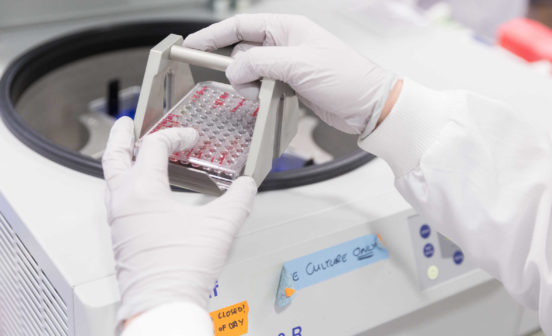Uncategorised Largest study delves into the impacts of dust on London Underground staff

Researchers have carried out the largest study to date on the potential health impacts of airborne dust on the London Underground. The research was funded by Transport for London and the NIHR Health Protection Research Unit in Environmental Exposures and Health, a partnership between the UK Health Security Agency and Imperial College London.
The research, led by Imperial College London, found that staff who worked in areas with higher levels of fine dust called particulate matter (PM), tended to report more episodes of sickness absence.
However, the researchers stress that the findings do not provide enough evidence to establish that exposure to PM directly leads to sickness absence and that more research is needed to confirm these potential links. It is also common in similar places of work for office-based staff to have lower absences than operational staff (e.g., engineering or maintenance staff).
The study, published in the journal Environment International, is the most comprehensive of its kind ever conducted to link air quality and health effects in a subway system and could have implications for subway networks around the world.
Dr David Green, from Imperial’s School of Public Health, who led the work, said: “We found that exposure to dust varied widely among staff, even among those doing the same job role, and depended largely on where they were working across the Tube network. For example, drivers who worked on older trains and on lines with deeper tunnels were exposed to more PM, as were customer service staff at stations with interchanges for multiple lines.
“There was some evidence to suggest that staff exposed to higher levels of PM took more days off sick, but this link wasn’t clear cut.”
In the meantime, the researchers say that targeted measures, such as new trains with reduced braking emissions, platform screen doors, increased ventilation, air cleaning and surface cleaning can all be used to reduce concentrations.
Workplace pollution
Previous studies of outdoor air pollution have established a clear link between exposure to particulate matter (PM) and ill health, especially the effect of the smallest particles (PM) on coronary heart disease, asthma, lung cancer and stroke. However, the health effects of PM in other environments, including places of work are less well understood.
There are various sources of emissions of PM within the network – mainly from the wear of rails, wheels and particles released when the train brakes, which tend to accumulate in the network. In a previous study, the research team found that levels of PM in parts of the network can be up to 15 times higher than in the air outside. These particles are different from those that make up outdoor PM and are likely to have different health impacts.
To investigate further, Dr Green and team examined a ‘pseudonymised’ dataset from Transport for London (TfL) which included 29,744 staff employed between 1 January 2014 and 31 December 2019 who all regularly worked on the London Underground network. Roles included drivers, customer service staff and fleet staff (which includes train engineers, depot staff and technical support). Some staff, such as track engineers, were excluded due to them using breathing apparatus for their job. Information about exposure to PM was available from personal monitors as well as a series of network-wide measurements at underground platforms and stations.
Data on sickness absences were obtained securely and under agreement from TfL’s Human Resources Department, using a method that protected individuals’ privacy.
Varying exposure
Analysing the data, the researchers found that exposure to PM differed significantly among staff and was dependent on the nature and location of their work. Drivers had the highest exposure over a work shift, but concentrations varied according to the line on which they worked – from an average of 72µg/m3 on the District Line to 787µg/m3 on the Piccadilly Line.
As a general rule, drivers with lower PM exposure worked on lines with shallow tunnels where there was a higher proportion of the track above ground and on trains introduced after 2010. On the other hand, drivers who experienced the highest exposure to PM worked on older trains, operating on lines with deeper tunnels with more of their time spent underground.
Exposure among customer service staff also varied, with customer service assistants experiencing higher exposure to PM (ranging from 17-310µg/m3) than customer service managers (9-154µg/m3), largely due to the duration of time spent on station platforms.
Levels of exposure also varied by station. Underground stations and interchanges for multiple lines had higher PM concentrations, compared to quieter, above-ground stations – likely due to higher train emissions and reduced ventilation.
A mixed picture
Looking at reported sickness, the researchers found that fleet staff, customer service staff and drivers all had higher rates of sickness absence due to any cause compared with non-exposed office workers.
The researchers looked more closely at sickness absence among drivers, using the District Line (which had the lowest recorded PM exposure) as a baseline and found that drivers on five out of eight lines showed elevated rates of all-cause sickness absence.
However, there was no clear ‘exposure-response relationship’, where researchers would expect to see increasing exposure associated with an increased sickness absence. Therefore, the researchers conclude that they cannot say for certain that PM exposure is directly contributing to sickness absence among London Underground staff.
Study limitations and future directions
The team cautions that there are some important limitations with the study method, particularly in using sickness absence as a measure for estimating someone’s health, as this can be complicated by people’s behaviour.
For example, during short-term absences, people often may not see a doctor and may misdiagnose and misreport/miss-record their illness – or they simply do not report it at all. Another reason is that illnesses may go unrecorded as people will still work even when unwell. This is more likely in some types of work environments, such as in an office, where it may be more socially acceptable to turn up to work, or to work from home, when feeling unwell.
Commenting on the findings, Imperial PhD candidate and first author of the study Justie Mak said: “While this study is one of the largest and most comprehensive of its kind, linking exposure to health effects in the human body is complicated – the effects may be too subtle to detect in this way or take a long time to develop. Chronic health impacts linked to dust exposure are likely to develop gradually, probably after prolonged inflammation. We are currently looking at the longer-term health effects among London Underground workers and will be reporting that later in the year.”
The team also notes that the study adds support for the implementation of measures that have previously been linked to reductions in PM exposure for staff and passengers. These include modernising trains and carriages, reducing emissions from activities such as braking, adding platform screen doors at stations and limiting exposure to staff with pre-existing health conditions.





